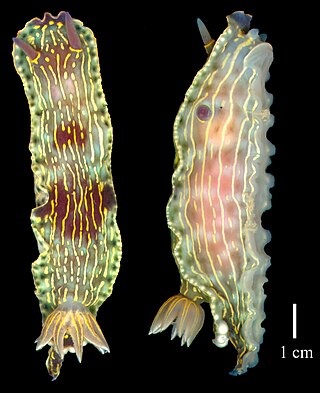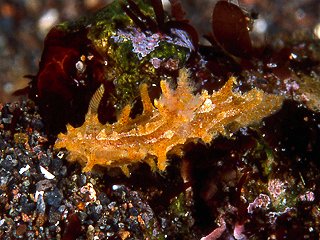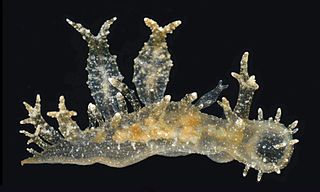
Graphium sarpedon, the common bluebottle or blue triangle in Australia, is a species of swallowtail butterfly that is found in East, South and Southeast Asia, as well as eastern Australia. There are approximately sixteen subspecies with differing geographical distributions.

Fiona pinnata, common name Fiona, is a species of small pelagic nudibranch, a marine gastropod mollusk in the superfamily Fionoidea. This nudibranch species lives worldwide on floating objects on seas, and feeds mainly on barnacles, specifically goose barnacles in the genus Lepas.

Alkenopterus is a genus of prehistoric eurypterid classified as part of the family Onychopterellidae. The genus contains two species, A. brevitelson and A. burglahrensis, both from the Devonian of Germany.

Felimare picta is a species of colourful sea slug or dorid nudibranch, a marine gastropod mollusk in the family Chromodorididae. Atlantic Ocean species of Hypselodoris were all transferred to Felimare following a DNA phylogeny.

Oxynoe viridis is a species of small sea snail or sea slug, a bubble snail, a marine gastropod mollusk in the family Oxynoidae.

Felimare bayeri is a species of colorful sea slug or dorid nudibranch, a marine gastropod mollusk in the family Chromodorididae. It was described by Eveline and Ernst Marcus in 1967.
Thorunna kahuna is a species of sea slug, a dorid nudibranch, a shell-less marine gastropod mollusk in the family Chromodorididae.
Plocamopherus lemur is a species of sea slug, a nudibranch, a shell-less marine gastropod mollusk in the family Polyceridae.
Plocamopherus maculapodium is a species of sea slug, a nudibranch, a shell-less marine gastropod mollusk in the family Polyceridae.
Plocamopherus pecoso is a species of sea slug, a nudibranch, a shell-less marine gastropod mollusk in the family Polyceridae.
Plocamopherus margaretae is a species of sea slug, a nudibranch, a shell-less marine gastropod mollusk in the family Polyceridae.

Kaloplocamus peludo is a species of sea slug, a nudibranch, a shell-less marine gastropod mollusc in the family Polyceridae.
Kaloplocamus maru is a species of sea slug, a nudibranch, a shell-less marine gastropod mollusc in the family Polyceridae.
Pristomyrmex tsujii is a species of ant in the genus Pristomyrmex. Known from Fiji, where they are widely distributed but rarely encountered. The species has a discrete ergatoid queen caste that is intermediate between a worker and an alate queen.
Okenia mexicorum is a species of sea slug, specifically a dorid nudibranch, a marine gastropod mollusc in the family Goniodorididae.
Dendronotus niveus is a species of sea slug, a dendronotid nudibranch, a shell-less marine gastropod mollusc in the family Dendronotidae.

Melibe arianeae is a species of sea slug, a nudibranch, a marine gastropod mollusc in the family Tethydidae.

Helophilus fasciatus, the narrow-headed marsh fly, is an abundant species of syrphid fly observed throughout the United States and Canada. Hoverflies can remain nearly motionless in flight. The adults are also known as flower flies for they are commonly found on flowers, from which they get both energy-giving nectar and protein-rich pollen. The larvae of this genus are associated with wet decaying organic material, particularly accumulations of decaying vegetation in ponds and mud and farmyard manure or silage. The adults of this species lays eggs on vegetation overhanging the water. The larvae hatch and drop into the water.
Kankelibranchus alhenae is a species of sea slug, a nudibranch, a shell-less marine gastropod mollusc in the family Polyceridae.

Ligia platycephala is a species of isopod from the genus Ligia.









